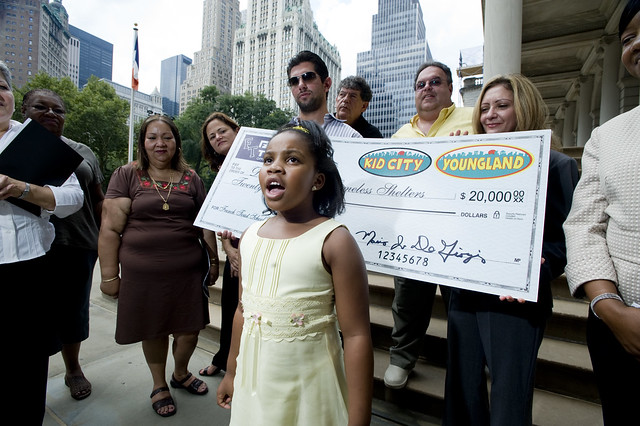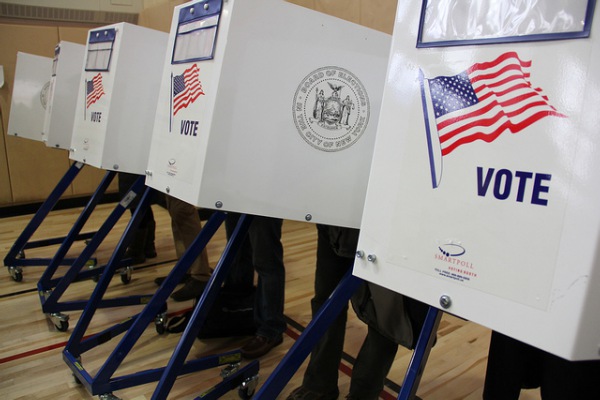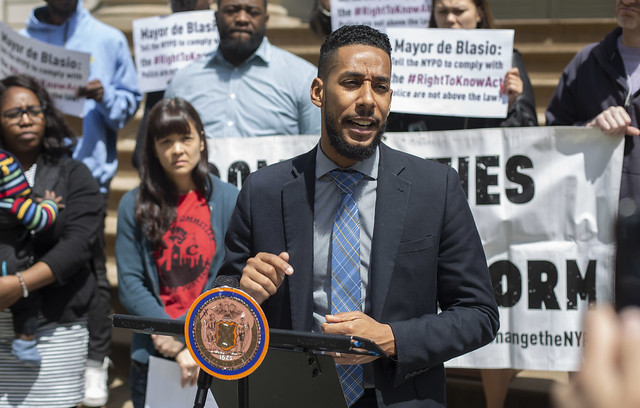New York City Should Give ‘Democracy Dollars’ to Kids

(photo: William Alatriste/City Council)
Senator and presidential candidate Kirsten Gillibrand wants to give all Americans $600 to donate to candidates for office. She believes this will level the campaign finance playing field and ween candidates from the corrupting influence of large donors and corporate PACs.
This is a well-meaning reform based on early success of the Democracy Voucher Program in Seattle, Washington, to diversify the pool of donors, yet it misses an important point. By restricting “Democracy Dollars” to eligible voters, one of our most important constituencies is again left out: young people.
According to the Pew Research Center, the pool of donors is as biased toward older voters as it is toward the wealthy and highly educated. A third of those over the age of 65 report giving a campaign donation compared to less than 10% of those 18-29 years old. In Seattle, older voters are much more likely to use a Democracy Voucher than younger voters, and minors are not even eligible.
Is it any wonder that New York City classrooms are crumbling and segregation continues to plague our schools? On issues that are most likely to affect young people in the future -- from quality schools to climate change to the ballooning federal debt -- lawmakers remain unable to find long-term solutions.
This is in part because the political voice of young people is muffled until they become eligible to vote at age 18, and after due to low voter turnout. As former Mayor Ed Koch famously quipped, “You don’t vote, you don’t count.”
Interestingly, federal law does not bar young people from making campaign contributions. In 2005, the U.S. Supreme Court found restrictions on campaign donations from minors unconstitutional. And Participatory Budgeting in New York City is already open to everyone over the age of 11.
This opens a window of opportunity for the city to continue to innovate in the area of equitable campaign finance. While the city’s existing Matching Funds Program does not match donations from minors, a new “Democracy Voucher Program for the Future” targeted at high school students could empower the leaders of the city in the decades to come.
Similar to Senator Gillibrand’s proposal, the approximately 400,000 students attending public and private New York City high schools would receive $5 vouchers that they could donate to eligible candidates for office. If students were each allotted two vouchers, this would generate a pool of up to $4 million.
This new program would potentially re-orient campaigns toward a newly powerful class of donors. Candidates would be compelled to articulate their views on the issues young people care about. Young people would be able to support candidates that speak to their issues and share a vision for the future of the city.
The program would also serve as a basis for high schools to encourage real political participation, not just theoretical. And in the longer-term, establishing the habit of political participation in high school is likely to greatly increase voter participation when students later become eligible.
Yes, the image of candidates soliciting donations on the steps of a local high school is strange. But, is it any stranger than courting developers at swanky restaurants or city contractors at private parties?
If you believe in changing the corrupting influence of big money in politics and energizing those left out of politics, then you should support empowering the city’s young people.
***
Heath Brown is associate professor of public policy at City University of New York, John Jay College and CUNY Graduate Center, and the author of Pay to Play Politics. On Twitter @heathbrown.
***
Have an op-ed idea or submission for Gotham Gazette? Email This email address is being protected from spambots. You need JavaScript enabled to view it.
A Closer Look at New York City Latino Voter Participation in the 2018 Elections

(photo: Mayor's Office)
NYC Votes and the Voter Assistance Advisory Committee recently released their mandated report regarding voting participation in New York City, which skyrocketed in 2018. While the report contains fascinating analyses, it does not, nor does it seek to, delve into the role that people of color, in this case specifically Latinos, played in last year’s elections. But their role was definitely pivotal, and it particularly affected the New York gubernatorial primary.
According to my own analysis, over half a million more voters came out to the polls in the 2018 Democratic primaries than in the 2014 primaries. Over a million more voters voted in the 2018 general election than in the 2014 general election.
This enormous increase in voting participation was evident across all racial groups. But of them all, the increase among Latino voters in New York City was slightly greater. Compared to the 2014 primaries, when Latinos comprised 17% of the overall New York City electorate (47,592 voters), in 2018 Latinos increased their voter share to 20% of the city electorate, with 169,667 Latinos going to the polls.
In the 2018 general election Latinos also comprised 20% of the city’s electorate, increasing their voter turnout by nearly 300,000 voters over the 2014 general election.
Of these, 55% of the Latino vote came from two boroughs—the Bronx and Manhattan—and 42% of the Latino vote came from Brooklyn and Queens. One interesting change from previous elections is that the Latino vote in Queens has increased. In previous years, Manhattan made up almost 30% of all Latino voters but that number is now dwindling, in my estimation likely because of the decrease in Puerto Rican voters in East Harlem and the Lower East Side.
But Queens has seen a spike in Latino voting participation, with 30,000 more voters going to the polls in 2018 than in 2014. Queens Latino voters now comprise 21% of all Latino voters in the city, the largest increase in percentages of all the boroughs. In the 2018 general election, Queens residents made up a quarter of all Latino voters. The Bronx remains the borough with the most Latino voters.
Lest you think this column is painting too rosy a picture of Latino voting participation, here’s the reality check: only 20% of all eligible Latino Democratic voters in New York City voted in the 2018 Democratic primary. In the 2018 general election, 37% of all eligible registered Latinos voted in New York City. In comparison, 45% of registered black voters in the city went to the polls in the general election.
To be sure, the lack of Latino voting participation in New York City is not unique to Gotham. Studies indicate that this lack of participation is prevalent nationally. This has been well documented by Bernard Fraga in his book The Turnout Gap. There, Fraga observes on the basis of careful research that Latino (along with Asian-American) voting participation lags behind all other groups nationally.
Clearly, much remains to be done when it comes to pushing for a greater electoral presence among Latinos. The question is whether its leaders, particularly Latino elected officials, have the wherewithal to make this a priority.
The most recent citywide election (the February special election for public advocate) barely turned out 10% of Latino voters. Granted, all political observers predicted that this election would be a low-turnout affair. But the abysmal turnout among Latinos should raise many questions of concern and should compel Latino leaders to strategize ways to increase voting participation. Otherwise, the “sleeping giant” moniker given to Latinos will persist.
***
Eli Valentin teaches political science at Monroe College and is a frequent guest political analyst on Univision NY. On Twitter @elivalentinNY.
***
Have an op-ed idea or submission for Gotham Gazette? Email This email address is being protected from spambots. You need JavaScript enabled to view it.
State Lawmakers Must Help Launch a New Era of NYPD Transparency and Accountability

Council Member Reynoso, one of the co-authors (photo: John McCarten/City Council)
In recent history, New Yorkers have witnessed numerous instances of brutality and mistreatment at the hands of the police. Justice has not been delivered in many of these cases, and they all point to a glaring reality: a lack of transparency and accountability plagues the New York City Police Department.
The public was vividly reminded of this just a few weeks ago when a video of Christopher Parham’s 2018 arrest surfaced. In the video, 19-year-old Parham is seen picking up groceries for the restaurant where he worked when three plainclothes officers followed him outside of the grocery store and threw him to the ground, violently arresting him without cause. The officer who took him into custody – an officer with a history of civil rights lawsuits – and his colleagues slammed his head onto the sidewalk of a busy Williamsburg street, giving him a concussion and tasing him repeatedly before dragging him backwards by his handcuffed arms into a police car.
Despite the fact that this brutal assault occurred in broad daylight in front of witnesses, and was captured on cell phones and security camera, paperwork completed by the NYPD indicated that no force had been used during the arrest. The NYPD says an internal investigation cleared the officers who attacked him of wrongdoing.
The charges filed against Parham were eventually dismissed following the District Attorney’s review of surveillance footage obtained by Brooklyn Defender Services and our partnership advocating on his behalf. However, Parham’s experience with law enforcement is not unique, and residents of New York City are not strangers to officers with problematic histories patrolling their streets.
Stories like Parham’s are why we support the SaferNY Act, a package of bills currently in the New York State Legislature that aims to increase police accountability through measures such as repealing section 50-a of the state’s Civil Rights Law, which shields police personnel records; enacting the Police Statistics and Transparency (STAT) Act; and strengthening the role of the Special Prosecutor currently enacted by executive order.
Police departments in New York are tasked with disciplining their own officers, which means that officers who commit crimes, ranging from lying under oath to murder, are allowed to keep their jobs, even after an assessment of potential wrongdoing has been made. In this enormously flawed law enforcement disciplinary system – one where, for example, a finding of wrongdoing by the New York City Civilian Complaint Review Board and Internal Affairs Bureau investigations does not guarantee that officers are penalized – the personnel records of police officers remain sealed under 50-a.
Under 50-a, the information contained in personnel files, including investigations and findings of fact, are sealed from public scrutiny. This is problematic because the publicly available records paint an incomplete picture, one that judges and prosecutors are all too able to ignore at the NYPD’s urging. As a result, even when numerous public civil lawsuits have been filed, they are not considered as findings of fact or determinations of guilt and most of these cases settle out of court.
The public is starting to learn of some of the most problematic cases and worst offenders, however they have yet to be held accountable. As an example, Sgt. David “Bullethead” Grieco has been named in more than 30 lawsuits with allegations including physical violence and lying under oath. Yet despite his egregious track record, cases brought by this officer are still being prosecuted.
If we want a city that is safe, fair, and equitable, we must hold all citizens to the same standards and levels of accountability, including members of our law enforcement. It shouldn’t take a City Council member and advocates to join forces to protect individuals like Christopher Parham from those who are supposed to protect us.
Parham wants to move on with his life, “I just don’t want this to happen to anyone else,” he says. It is in the hands of the New York State Legislature to get us closer to this goal, and that is why we urge our state lawmakers to pass the SaferNY Act before the end of this session in Albany.
***
City Council Member Antonio Reynoso represents parts of Brooklyn and Queens. Lisa Schreibersdorf is Executive Director and Founder of Brooklyn Defender Services. On Twitter @CMReynoso34 & @lisaschreib.
***
Have an op-ed idea or submission for Gotham Gazette? Email This email address is being protected from spambots. You need JavaScript enabled to view it.




